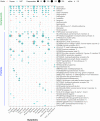Network pharmacology suggests biochemical rationale for treating COVID-19 symptoms with a Traditional Chinese Medicine
- PMID: 32811894
- PMCID: PMC7434773
- DOI: 10.1038/s42003-020-01190-y
Network pharmacology suggests biochemical rationale for treating COVID-19 symptoms with a Traditional Chinese Medicine
Abstract
Chinese herbal formulas including the lung-cleaning and toxicity-excluding (LCTE) soup have played an important role in treating the ongoing COVID-19 pandemic (caused by SARS-CoV-2) in China. Applying LCTE outside of China may prove challenging due to the unfamiliar rationale behind its application in terms of Traditional Chinese Medicine. To overcome this barrier, a biochemical understanding of the clinical effects of LCTE is needed. Here, we explore the chemical compounds present in the reported LCTE ingredients and the proteins targeted by these compounds via a network pharmacology analysis. Our results indicate that LCTE contains compounds with the potential to directly inhibit SARS-CoV-2 and inflammation, and that the compound targets proteins highly related to COVID-19's main symptoms. We predict the general effect of LCTE is to affect the pathways involved in viral and other microbial infections, inflammation/cytokine response, and lung diseases. Our work provides a biochemical basis for using LCTE to treat COVID-19 and its main symptoms.
Conflict of interest statement
The authors declare no competing interests.
Figures






Similar articles
-
Network pharmacological approach for elucidating the mechanisms of traditional Chinese medicine in treating COVID-19 patients.Pharmacol Res. 2020 Sep;159:105043. doi: 10.1016/j.phrs.2020.105043. Epub 2020 Jun 20. Pharmacol Res. 2020. PMID: 32569819 Free PMC article.
-
Databases for facilitating mechanistic investigations of traditional Chinese medicines against COVID-19.Pharmacol Res. 2020 Sep;159:104989. doi: 10.1016/j.phrs.2020.104989. Epub 2020 Jun 2. Pharmacol Res. 2020. PMID: 32502638 Free PMC article. No abstract available.
-
The database-based strategy may overstate the potential effects of traditional Chinese medicine against COVID-19.Pharmacol Res. 2020 Sep;159:105046. doi: 10.1016/j.phrs.2020.105046. Epub 2020 Jun 23. Pharmacol Res. 2020. PMID: 32590099 Free PMC article. No abstract available.
-
Review on the potential action mechanisms of Chinese medicines in treating Coronavirus Disease 2019 (COVID-19).Pharmacol Res. 2020 Aug;158:104939. doi: 10.1016/j.phrs.2020.104939. Epub 2020 May 21. Pharmacol Res. 2020. PMID: 32445956 Free PMC article. Review.
-
Herbal plants coordinate COVID-19 in multiple dimensions - An insight analysis for clinically applied remedies.Int J Med Sci. 2020 Oct 22;17(18):3125-3145. doi: 10.7150/ijms.50260. eCollection 2020. Int J Med Sci. 2020. PMID: 33173434 Free PMC article. Review.
Cited by
-
Preclinical findings: The pharmacological targets and molecular mechanisms of ferulic acid treatment for COVID-19 and osteosarcoma via targeting autophagy.Front Endocrinol (Lausanne). 2022 Sep 20;13:971687. doi: 10.3389/fendo.2022.971687. eCollection 2022. Front Endocrinol (Lausanne). 2022. PMID: 36204096 Free PMC article.
-
Traditional Chinese medicine in COVID-19.Acta Pharm Sin B. 2021 Nov;11(11):3337-3363. doi: 10.1016/j.apsb.2021.09.008. Epub 2021 Sep 20. Acta Pharm Sin B. 2021. PMID: 34567957 Free PMC article. Review.
-
The Role of Traditional Chinese Medicine and Chinese Pharmacopoeia in the Evaluation and Treatment of COVID-19.Curr Pharm Des. 2024;30(14):1060-1074. doi: 10.2174/0113816128217263240220060252. Curr Pharm Des. 2024. PMID: 38523518 Review.
-
Herbal Formula Modified Bu-Shen-Huo-Xue Decoction Attenuates Intervertebral Disc Degeneration via Regulating Inflammation and Oxidative Stress.Evid Based Complement Alternat Med. 2022 Feb 2;2022:4284893. doi: 10.1155/2022/4284893. eCollection 2022. Evid Based Complement Alternat Med. 2022. PMID: 35154344 Free PMC article.
-
TCMKD: From ancient wisdom to modern insights-A comprehensive platform for traditional Chinese medicine knowledge discovery.J Pharm Anal. 2025 Jun;15(6):101297. doi: 10.1016/j.jpha.2025.101297. Epub 2025 Apr 10. J Pharm Anal. 2025. PMID: 40635974 Free PMC article.
References
Publication types
MeSH terms
Substances
LinkOut - more resources
Full Text Sources
Miscellaneous

